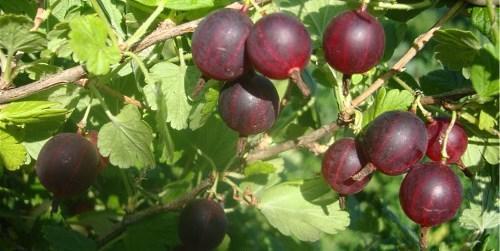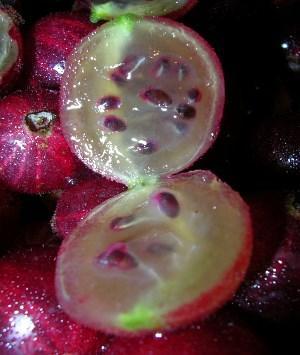Gooseberry Commander - planting and caring for the bush
 Gardeners - amateurs a lot of grief are delivered by sharp thorns on gooseberry bushes. You can get used to this feature of the plant, but sometimes you have neither thick gloves nor long-handled scissors at hand. Fortunately, breeders have been able to develop thornless varieties, which, moreover, produce excellent yields of sweet and aromatic berries. These include the Commander gooseberry.
Gardeners - amateurs a lot of grief are delivered by sharp thorns on gooseberry bushes. You can get used to this feature of the plant, but sometimes you have neither thick gloves nor long-handled scissors at hand. Fortunately, breeders have been able to develop thornless varieties, which, moreover, produce excellent yields of sweet and aromatic berries. These include the Commander gooseberry.
Gooseberry species
Gooseberry has many names: goose berry, agrus, northern grapes, kryzh, etc. The shrub is good because it can be planted in different soil, and it is surprisingly quickly mastered in new conditions.
Gooseberries are an excellent neighbor for other fruit and berry crops and are divided into two groups:
- Varieties that owe their origin to European craftsmen. These include: Triumphal, Industry, Green Bottle, Date and others. This group of shrubs has thorns, and every year brings many sweet and large berries, reaching 50 g. They are demanding shrubs that require careful maintenance. They tolerate frost rather badly. Young shoots are unstable to insidious powdery mildew.
- Varieties that have been obtained by hybridizing the above European varieties with wild gooseberry varieties, and with their American "brothers". These shrubs are not so demanding in terms of planting and care, they quickly form new shoots. These are: Chernomor, Baltic, Beryl, etc. But, acquiring new qualities, these varieties began to noticeably yield to the first group in terms of taste of berries, which grow not so large and do not have such a pronounced sweetness, as, for example, Date or Triumphalny.
All about the Commander
It is a dense, medium-sized gooseberry that has strong and not too thick shoots of light green color. From the sunny side below, the branches have a pinkish tint. The bush has no thorns.

The leaves are large, shiny, strong. The base of the leaf has a small depression, it is round or flat. The teeth are medium in size, sharp. The buds have an elongated oval shape, the tops are pointed.
The flowers are very beautiful, sometimes small, more often - medium, have the form of a bowl, are painted in a greenish-yellow color with a faint pink tint, have two or three inflorescences.
The berries are medium - up to 5.5 g or large - up to 7 g in size, colored brown-red, which is why the shrub is called red gooseberry not prickly. The skin of the fruit is thin or of medium thickness. The berries have a tart, sweet-sour taste, very pleasant.
This variety produces a good annual yield. The shrub is rarely affected by powdery mildew; sawflies do not like it.
Rules for planting gooseberry Commander
Soils are well suited for planting the Commander:
- sandy loam,
- loamy;
- sod-podzolic.
 Gooseberry Commander must be planted correctly. It is better to fence off a site that will be protected from gusts of wind on all sides, but at the same time the sun's rays will freely warm the branches of young shrubs. Do not choose places where water stagnates. This circumstance can cause the death of the gooseberry and its infection with powdery mildew.
Gooseberry Commander must be planted correctly. It is better to fence off a site that will be protected from gusts of wind on all sides, but at the same time the sun's rays will freely warm the branches of young shrubs. Do not choose places where water stagnates. This circumstance can cause the death of the gooseberry and its infection with powdery mildew.
Planting the Komandor gooseberry begins with work on the ground. It is necessary to dig holes 30 cm deep and about 60 cm in diameter. It is better if this is done in advance. A young plant needs fertilizers, therefore, up to 10 kg must be placed in each earthen depression. manure strawy, 300 g.wood ash (40 g of potash salt is also suitable as a replacement), up to 350 g of limestone, ground into powder.
Seedlings are placed in the holes not at an angle, but straight. The neck of the bush should hide under an earthen embankment at a depth of 6 cm, branches at the surface of the earth can be sprinkled with earth. The soil must be compacted and the bush must be watered abundantly with 5 liters of water.
Care features
A lot of water will leak when the gooseberry Commander gains strength from year to year. The description of the variety also includes features for the daily care of the plant. The shrub loves water, so gooseberry bushes need to be watered regularly, especially on dry summer days and two weeks before harvesting. The soil under the bush must be loosened, but this must be done with extreme caution so as not to hurt the plant's root system. In the first year after planting, the Commanderless gooseberry needs nitrogen fertilizers, which are made at the rate of up to 20 g per 1 sq. circle at the trunk.
What will pruning give?
 After the young bushes are planted, after a year by the fall, shoots grow, of which up to 5 of the healthiest and strongest should be left. By the end of the second year, more shoots will be added to the existing branches. They also need to be reduced to 4-5. In subsequent years, caring for gooseberries requires maintaining from 3 to 5 branches equally spaced from each other. When 5-6 years have passed, it is better to cut off old and diseased shoots: 3-4 every year, leaving such a number of annual branches at the roots.
After the young bushes are planted, after a year by the fall, shoots grow, of which up to 5 of the healthiest and strongest should be left. By the end of the second year, more shoots will be added to the existing branches. They also need to be reduced to 4-5. In subsequent years, caring for gooseberries requires maintaining from 3 to 5 branches equally spaced from each other. When 5-6 years have passed, it is better to cut off old and diseased shoots: 3-4 every year, leaving such a number of annual branches at the roots.
Pruning should be done in early spring, before sap flow has begun, or even better in autumn, after the leaves have fallen from the trees. It is undesirable to leave stumps, which are an excellent "residence" for garden pests. You cannot break off branches manually. Pruning shears, a garden saw, or garden shears are used for pruning.
very detailed description